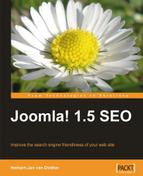Apart from the reasons discussed in previous section, one more important reason to get a W3C-valid template is to get the best performance in terms of the loading time of your web site. W3C validation makes loading of pages faster in your visitor's browser, as that browser has to do fewer corrections to the markup. Spiders such as Googlebot and Inktomi slurp can read the code faster and can easily find the real content on your page. With the right validation, your page loads faster and this is also one of the aspects that Google takes into account. The better and faster your pages are loading, the better your position will be. So, try to find a template that has 80, or if possible 90 percent valid code after you have installed your extra code and components.
What is code positioning anyway? In simple terms, it is the way in which the code for your HTML page is generated.
There are several ways in which you can generate your page using the template of your Joomla! web site:
- In sequential order, which means that the page is built following the guidelines from top to bottom—first the header, then the left side modules followed by the content, and then the right side modules and the footer
- In search engine optimized order, which means that first the content, then the header, followed by the left and right modules, and then the footer
A search engine optimized template will follow the latter, now why should you care? The page layout in both cases can be identical. There is no difference to the visitor of your web site, but there is a difference for the Search Engine Robots. They get the most important information first, before all the other code is shown to them. This is also the reason why I use the right menu option instead of the left one, as there are only a few well-optimized Joomla! templates.
Most template builders don't go that deep into Search Engine Optimization, currently I know of the following three:
- One site that has a few source coded SEO'd templates is joomlashack.com
- Second are the specially built Bolt and Breeze templates from alledia.com
- Third in line is Rocket theme with their free afterburner template http://www.rockettheme.com/joomla-templates/afterburner
There are a lot of great templates that are really well coded and could even outperform these special templates. If you feel that these special, highly optimized templates are suited for your site and, if your site's audiences like them, you should go for the best and fastest template you can get.
How to look for optimized code? Just open up a source code viewer and read through the generated HTML. If you find that the real content of your article is way down below all the other kinds of coding, you know it's not optimized with code positioning.
Modern day templates should not use tables anymore to position their content, and neither should you. Stay away from templates that are built with tables to set the layout. Using tables in this manner provides you with a slow loading page as most of the positioning is done with tables in tables in tables, and so on.
Table-based templates are slow to generate in browsers compared to XHTML and CSS templates. Each table has to be completely built before the one inside it is built. You can see that if you have a large number of tables, it will take time to show the page to your visitor.
Even with the best template that is created with only XHTML and CSS, you will see tables in a Joomla! web site. Even with a Joomla! 1.5 site, Joomla! in its core system creates tables, rows, and cells to position the content. The work to get a table less Joomla! version is in process, but if that will make it into Joomla! 1.6 is not clear at this moment. However, you can still minimize the number of tables used by choosing a template that is not built around tables. To strip the tables from your output, yootheme.com offers a free template override (http://www.yootheme.com/member-area/downloads/category/templates-15). Make sure to carefully follow the instructions for implementation and check your layout and CSS afterwards. Not all templates will work with this override so make sure you make a backup of your template.
You can easily identify a table-based template by looking at the source code of the index file of the template. If you see all kinds of <table> <tr> and <td> coding, look further. If you see a lot of <div> and <class> tags in the source code, it is worth investigating if this template suits you.
